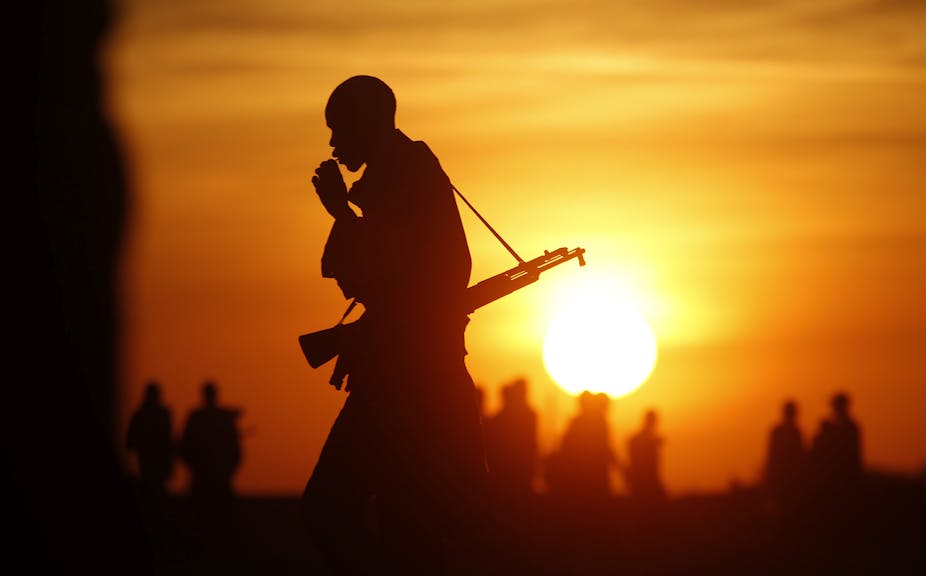South Sudan’s protracted political crisis has increased in complexity as the the main actors fragment into factions or form new alliances and the dynamics of the conflict change. This means that the search for lasting peace will have many more players around the table. Andrew Edward Tchie scopes out the landscape following the defection of yet another senior general to opposition ranks.
Can you give some background on the rebel groups or militias fighting Salva Kiir’s government?
The number of rebel groups and local militias continues to rise, and will probably continue to do so. Six is the number often cited but this could easily be off the mark. Certainly it does not include numerous local factions. The lack of up-to-date information is a problem even for the international community’s understanding of the South Sudan conflict. The Intergovernmental Authority on Development for example only officially recognises the Sudan People’s Liberation Army-In Opposition (SPLA-IO).
SPLA-iO, is led by Riek Machar. The second of the six is the recently-formed National Salvation Front led by Thomas Cirilo Swaka and the third is the National Democratic Movement led by former Agriculture Minister, Lam Akol. Others are Hakim Dario’s the People’s Democratic Movement, the South Sudan National Movement for Change led by former governor of Western Equatoria Joseph Bangasi Bakosoro and, finally, the Former Political Detainees.
The SPLA-iO is the biggest and somewhat multi-ethnic opposition group. It split from the ruling Sudan Peoples’ Liberation Movement in 2013 after a rift between President Salva Kiir and Riek Machar.
But SPLA-iO has recently lost members who defected to another group while gaining new ones in the former Central Equatoria regions. It probably remains the main opposition group but its strength is unclear.
The National Salvation Front (NSF) was formed in March. It immediately joined forces with the South Sudan Democratic Front (SSDF), which was formed in August 2007.
Swaka, the leader of the NSF, is a former deputy head of logistics in the military. But he turned against President Salva Kiir, who is Dinka, claiming that he had turned the Sudan People’s Liberation Army (SPLA) into an exclusively Dinka “tribal army”.
Where is the fighting most intense and why?
The main areas of conflict to date are in Equatoria region, Wau State and the former Unity state. These three states continue to experience difficult local conflicts whose intensity varies and have included ethnically targeted violence against civilians.
There has also been increased fighting in the Upper Nile. I have heard claims that the Sudanese Government may be funding local Shilluk militias here in return for some form of future agreement linked to oil fields.
The fighting is over several different but resolvable issue, the creation of new states, land distribution or just driven by local political grievances. This is often exacerbated by abusive security responses that consistently fail to protect local people and drive support to rebel groups.
Armed opposition groups and disaffected communities have little confidence in Kiir’s ability or willingness to deal with the conflict. This is reflected in the lack of shared access to land and distribution of resources in South Sudan and by the inability of Kiir’s government to deal fairly with citizens as the 2016 crisis in Juba showed.
What is the way out?
Many of South Sudan’s differences are political and include unresolved grievances between the national government and local communities. Many of these could be solved through tolerance, time and good mediation between the government and its own people.
The endless formation of rebel groups will be a new but continuous source of instability in a country where escalating violence has already uprooted an estimated 3 million people. Famine has already been declared and is set to spread to other regions in the coming months.
While there is an increasing and diverse opposition to Kiir, these groups lack a shared agenda and common approach. There is no group that promises a unified future for South Sudan. That ultimately undermines their collective abilities to confront Kiir’s consolidation of power.
There is a danger that international actors will focus excessively on leaders demands and as a result fail to understand the rapidly changing domestic dynamics.
Today’s armed opposition is fragmented. There are far too many groups with little or no linkage to any of the main groups. This means that even if Riek Machar were to follow Kiir’s lead in declaring a ceasefire, the fighting would likely continue. Securing a durable ceasefire requires an acceptance of all the relevant individual commanders and factions.
Certainly the solution to South Sudan’s crisis does not lie in the battlefields. Local and regional players should think more closely about how to empower local churches, civil society and local communities to facilitate locally owned peace. This could ultimately help foster steps towards forgiveness, reconciliation and peace-building.

